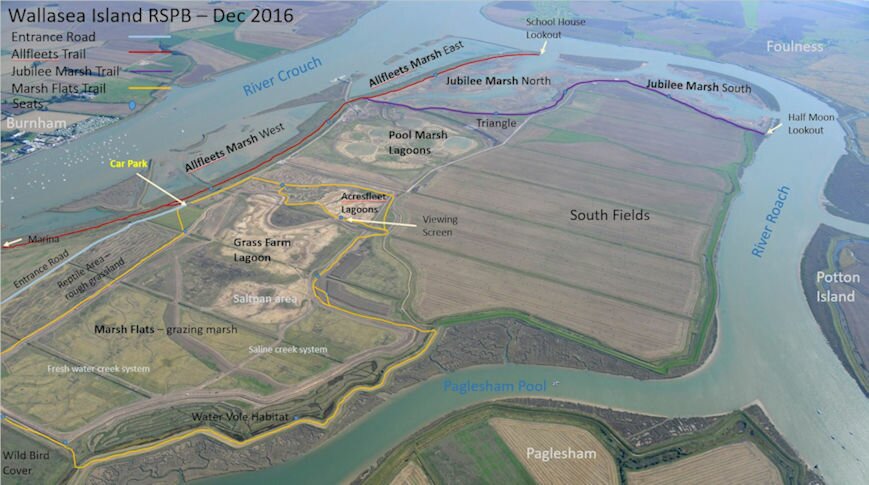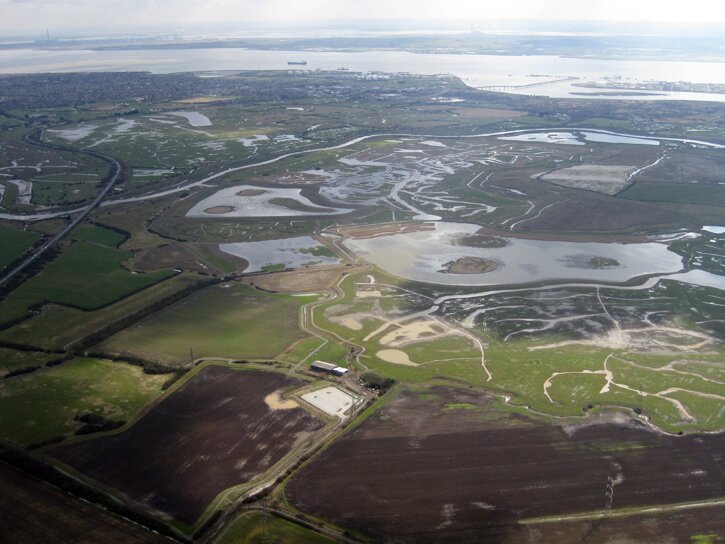RSPB South East Essex Reserves
Now you can join our friendly RSPB Reserve communities. Not only can you read all the latest on our local reserves but you can also have fun sharing your experiences, showing off your photos and getting in touch with other people. Read the latest news and join the forums to have your say:
RSPB South Essex Marshes Community Page
RSPB Bowers Marsh

Bowers Marsh
RSPB West Canvey Marsh
RSPB Vange Marsh
RSPB Wallasea Island

RSPB Wallasea Island Footpaths
RSPB Rainham Marshes

South Essex Reserves
On 1st December 2005 the RSPB acquired 25ha (62 acres) at Vange Marsh North, on a long lease from Basildon District Council. Since this time we have been carrying out our plans to Install a sophisticated tilting weir sluice to allow precise control of water levels which will create a mosaic of water, mud and vegetation, with water levels adjusted to provide optimum conditions for wintering, breeding and passage birds.
We also plan to open up the blocked sluice that created the ‘lake’, to allow the creation of a 1ha bunded saline lagoon habitat with islands. The works proposed will also benefit a range of other wildlife - not just birds and this will allow us to provide a site that is usable by as many birds as possible. In the longer term we plan to have a footpath connecting the site to Wat Tyler Country, via a bridge over Pitsea Creek.
Vange Marsh North has been a good site intermittently in the past. Our plans will ensure that it is consistently managed for the years to come, allowing the development of a sustainable wetland wildlife community. At the same time as acquiring Vange Marsh North, we also acquired 93ha (230 acres) at Vange Wick Marshes. Plans are at an advanced stage to re-wet these marshes and manage them for a similar range of birds and other wildlife.
West Canvey Marshes: We acquired2 this 254ha site, from Morrison's Supermarkets, on 30th March 2006. Progress to-date has concentrated on site investigation, including a full ground survey and a range of ecological surveys. Habitat management and people engagement proposals will be out for extensive consultation in the near future.
We have a visitor centre at Wat Tyler Country Park where you can visit us for more infomation and find out how to join the RSPB.
Wallasea Island
The RSPB Wallasea Island Wild Coast Project has four main aims:
- To create new intertidal habitats to compensate for losses in the Crouch and Roach Estuary and to offset historic losses of coastal Biodiversity Action Plan habitats and species in the UK.
- To avoid the flood damage risks to the Crouch and Roach Estuary and Wallasea Island that exist from a future unmanaged breach of the existing sea wall within the project area.
- To create an extensive area of accessible coastal land for the quiet enjoyment of nature and open space, reconnecting people with their coastal heritage.
- To demonstrate through a large-scale practical example adaptation to climate change and sea level rise on the coast.
The RSPB started talking to the major landowner on Wallasea Island in 2000, leading eventually to the RSPB signing a 2-year option to buy 738ha of land on the Island in 2007. The two-year period was to allow a scheme to be devised, consents to be obtained and funding secured on what is a multi-million pound project – the largest so far attempted by the RSPB in the UK. The RSPB plans to acquire the first portion of land on the island in September 2009.
Project development costs are in excess of £750k to develop a socially and environmentally acceptable design and obtain the necessary consents. Hydrodynamic studies have shown that the sustainable capacity for water flow onto/off the island per tide is around 3 million m3. An unmanaged breach would allow 11 million m3 of water onto the island.
We plan to import 7.5 million m3 of inert fill by sea from Crossrail and others, the placement of this fill will raise the land level to reduce the capacity of the island to a designed level of two million m3. The imported fill will be placed to produce the ground heights required for the range of habitats – mudflat, saltmarsh, saline lagoon and brackish marsh/pasture. Six 100m wide seawall breaches will be created to allow the free flow on/off the inter-tidal habitats. The site will be built up in cells – each with own sea defences. In due course visitor facilities, including five bird hides, two car parks and15km new paths will be added.
The Wallasea Wild Coast project is our most ambitious plan so far to restore lost coastal wetlands on a huge scale – an area 2 ½ times the size of the City of London.
Other Pages
-
RSPB Reserves
Local RSPB reserves -
Contacts
Local RSPB contacts -
Local Group Membership
Join the SEE Local Group -
Join our 100 Club
A great way to support the RSPB -
Advice
Useful advice -
Search
Search our site - National RSPB website